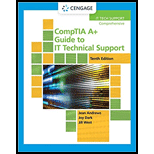
a.
Explanation of Solution
Given:
An organization that has set up three security levels on data that are accessed by users.
Data in the C:/Public folder is categorized as low-security data.
Data in a shared folder that some users can access is categorized as medium-security data.
Data in an encrypted and shared folder which needs a password is categorized as high-security data.
To find:Â The data of the party of the company, which was held on 4 July, should be kept at which security level.
Solution:
The data of the party of the company, which was held on 4 July, can be categorized in the low-security level. The data will be stored in the public folder of C drive in the system.
b.
Explanation of Solution
Given:
An organization that has set up three security levels on data that are accessed by users.
Data in the C:/Public folder is categorized as low-security data.
Data in a shared folder that some users can access is categorized as medium-security data.
Data in an encrypted and shared folder which needs a password is categorized as high-security data.
To find: The data of company’s invention, which has not been patented yet, should be kept at which security level.
Solution:
The data of company’s invention, which has not been patented yet, can be categorized in the high-security level as this is very important and confidential data of the company. The data will be stored in the encrypted and shared folder which requires a password to access the data.
c.
Explanation of Solution
Given:
An organization that has set up three security levels on data that are accessed by users.
Data in the C:/Public folder is categorized as low-security data.
Data in a shared folder that some users can access is categorized as medium-security data.
Data in an encrypted and shared folder which needs a password is categorized as high-security data.
To find:Â The data of resumes of different people, who applied in the company, should be kept at which security level.
Solution:Â
The data of resumes of the applicants can be categorized at the low-security level as resumes do not contain confidential information. The data will be stored in the public folder of the C drive of the system.
d.
Explanation of Solution
Given:
An organization that has set up three security levels on data that are accessed by users.
Data in the C:/Public folder is categorized as low-security data.
Data in a shared folder that some users can access is categorized as medium-security data.
Data in an encrypted and shared folder which needs a password is categorized as high-security data.
To find:Â The data of the payroll spreadsheet should be kept at which security level.
Solution:Â
The data of the payroll spreadsheet can be categorized at medium-security level as it will be accessed by some specific user who has the authority to access the payroll information. The data will be stored in the shared that can be accessed by some users.
e.
Explanation of Solution
Given:
An organization that has set up three security levels on data that are accessed by users.
Data in the C:/Public folder is categorized as low-security data.
Data in a shared folder that some users can access is categorized as medium-security data.
Data in an encrypted and shared folder which needs a password is categorized as high-security data.
To find:Â The data of job openings details of the company should be kept at which security level.
Solution:Â
The data of job openings in the company can be categorized at low-security level. The data will be stored in the public folder of the C drive of the system.
Want to see more full solutions like this?
Chapter 16 Solutions
Bundle: Comptia A+ Guide To It Technical Support, 10th + Mindtap, 1 Term Printed Access Card
- Np Ms Office 365/Excel 2016 I NtermedComputer ScienceISBN:9781337508841Author:CareyPublisher:Cengage

 Principles of Information Systems (MindTap Course...Computer ScienceISBN:9781305971776Author:Ralph Stair, George ReynoldsPublisher:Cengage Learning
Principles of Information Systems (MindTap Course...Computer ScienceISBN:9781305971776Author:Ralph Stair, George ReynoldsPublisher:Cengage Learning  Enhanced Discovering Computers 2017 (Shelly Cashm...Computer ScienceISBN:9781305657458Author:Misty E. Vermaat, Susan L. Sebok, Steven M. Freund, Mark Frydenberg, Jennifer T. CampbellPublisher:Cengage Learning
Enhanced Discovering Computers 2017 (Shelly Cashm...Computer ScienceISBN:9781305657458Author:Misty E. Vermaat, Susan L. Sebok, Steven M. Freund, Mark Frydenberg, Jennifer T. CampbellPublisher:Cengage Learning A+ Guide To It Technical SupportComputer ScienceISBN:9780357108291Author:ANDREWS, Jean.Publisher:Cengage,
A+ Guide To It Technical SupportComputer ScienceISBN:9780357108291Author:ANDREWS, Jean.Publisher:Cengage, Programming with Microsoft Visual Basic 2017Computer ScienceISBN:9781337102124Author:Diane ZakPublisher:Cengage Learning
Programming with Microsoft Visual Basic 2017Computer ScienceISBN:9781337102124Author:Diane ZakPublisher:Cengage Learning





